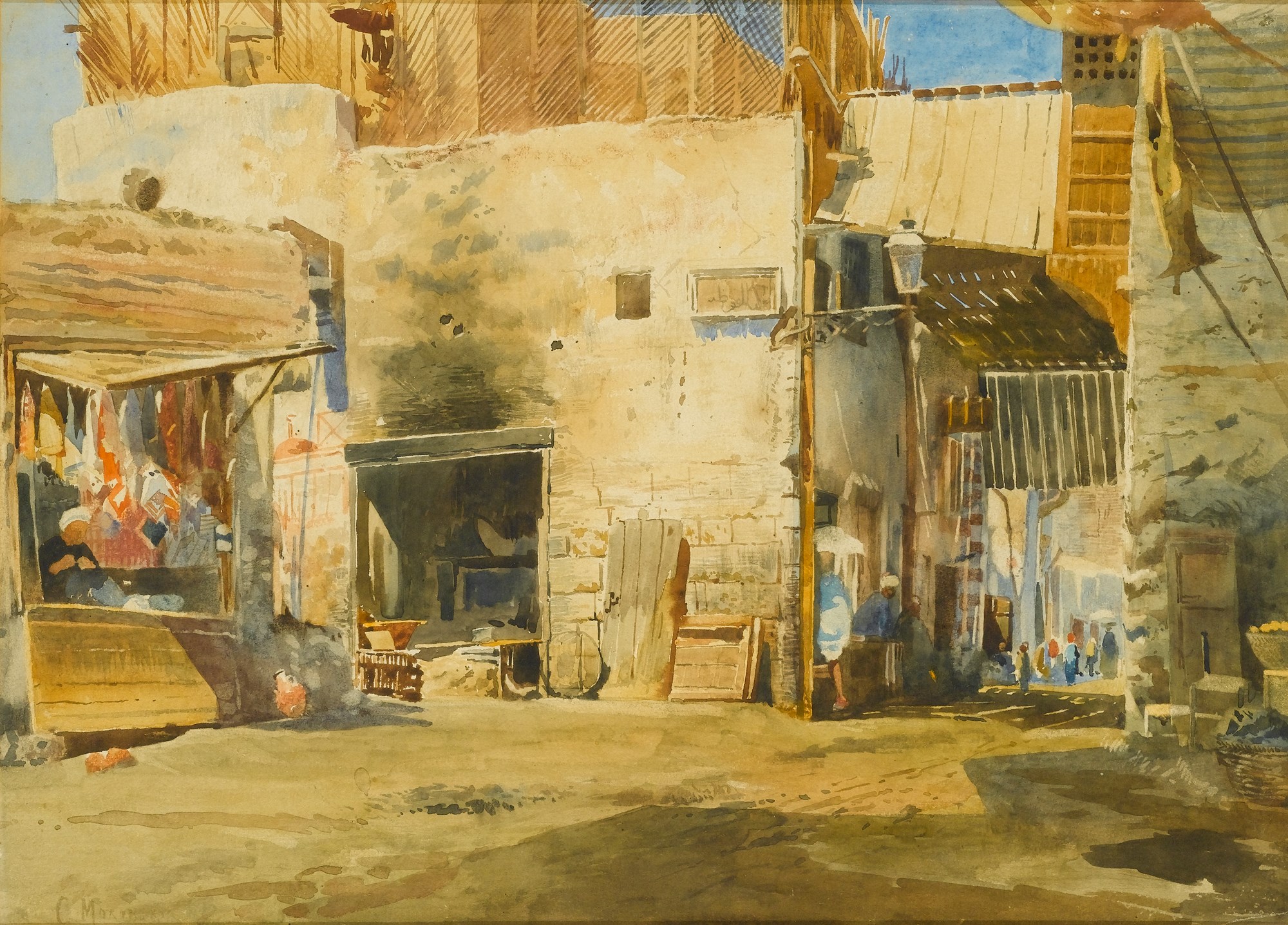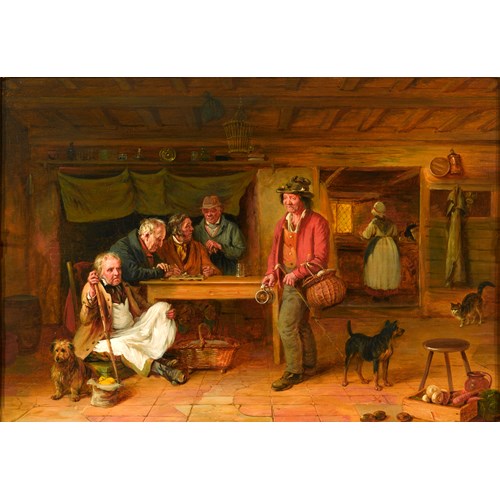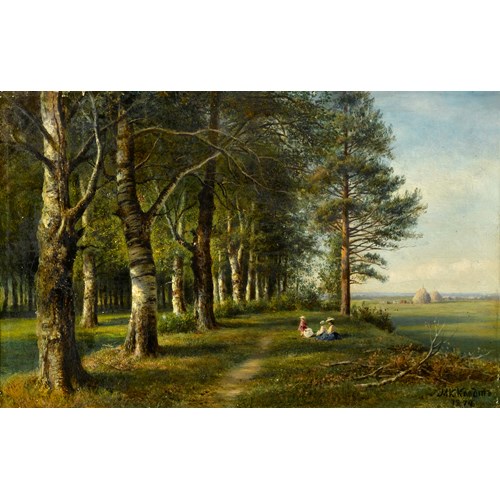Marketplace
A Cairo Street Scene
Konstantin Egorovich Makovsky
A Cairo Street Scene
Date 1870s
Period 1850-1900, 20th century
Origin Russia
Medium Watercolour on paper
Dimension 35 x 49 cm (13³/₄ x 19¹/₄ inches)
A Cairo Street Scene takes the viewer into the heart of a local neighbourhood, where homes, market stalls and social activity all co-exist simultaneously. Woven baskets filled with various goods and stacked crates sit on the right-hand side of the street. Striped canopies intermittently shelter the open spaces from the bright sunlight; while underneath a wooden walkway connecting two dwellings several men find respite in the shadows.
In the left foreground, within a wooden market stall, a solitary vendor sells fabrics of varying colour and length, his merchandise hanging from the roof. The man appears to be sewing, suggesting that his wares are handmade. As the watercolour was executed in Cairo, the materials on sale may be the colourful wrapped headscarves commonly worn by Egyptian men. They are often found in North African and Middle Eastern countries to provide protection from sun exposure as well as from dust and sand.
The building to the right of the stall appears to be a workshop, perhaps a blacksmith’s. The wall above the main doorway is singed with soot, and a fireplace can be spotted within. To the right of the doorway, a variety of items are propped up against the wall, awaiting attention. The roof is lined with wooden railings and it appears that the building is still under construction.
It seems likely that Makovsky painted the present scene during his trip to Egypt in the mid-1870s. There are a number of comparable watercolours from this period, and he later used these studies as the basis for fully worked up oil paintings. For example the alleyway depicted in A Cairo Street Scene features in the Nizhny Novgorod Art Museum’s Cairo. Makovsky has taken the exotic, ramshackle character of the watercolour and developed it, adding figures and detail to the building on the left-hand side. Thus the present watercolour provides a fascinating insight into Makovsky’s working methods.
Born in Moscow in 1839, Makovsky attended both the Moscow School of Painting and Sculpture, from 1851 to 1858, and the St. Petersburg Academy of Arts, from 1858 to 1863. In his final year at the Academy, alongside thirteen of his fellow students, he refused to complete the final examination piece believing the subject matter to be insufficiently representative of the essence of Russian culture. Leaving the Academy with the title of Artist of the Second Degree, Makovsky and some of the rebellious artists formed the St. Petersburg Artel of Artists group, a precursor to ‘The Wanderers’, or Peredvizhniki group.
Makovsky travelled to Egypt in the mid 1870s, and it is most probable that he carried out a series of studies capturing local culture, including the present work, during his visit to the country. Like the British Orientalist painters of the nineteenth century, Makovsky was lured by the exoticism and heady street-culture found in North Africa, and works such as A Cairo Street Scene, completed in situ, sought to convey the immediacy, impact and vibrancy of the location.
In the left foreground, within a wooden market stall, a solitary vendor sells fabrics of varying colour and length, his merchandise hanging from the roof. The man appears to be sewing, suggesting that his wares are handmade. As the watercolour was executed in Cairo, the materials on sale may be the colourful wrapped headscarves commonly worn by Egyptian men. They are often found in North African and Middle Eastern countries to provide protection from sun exposure as well as from dust and sand.
The building to the right of the stall appears to be a workshop, perhaps a blacksmith’s. The wall above the main doorway is singed with soot, and a fireplace can be spotted within. To the right of the doorway, a variety of items are propped up against the wall, awaiting attention. The roof is lined with wooden railings and it appears that the building is still under construction.
It seems likely that Makovsky painted the present scene during his trip to Egypt in the mid-1870s. There are a number of comparable watercolours from this period, and he later used these studies as the basis for fully worked up oil paintings. For example the alleyway depicted in A Cairo Street Scene features in the Nizhny Novgorod Art Museum’s Cairo. Makovsky has taken the exotic, ramshackle character of the watercolour and developed it, adding figures and detail to the building on the left-hand side. Thus the present watercolour provides a fascinating insight into Makovsky’s working methods.
Born in Moscow in 1839, Makovsky attended both the Moscow School of Painting and Sculpture, from 1851 to 1858, and the St. Petersburg Academy of Arts, from 1858 to 1863. In his final year at the Academy, alongside thirteen of his fellow students, he refused to complete the final examination piece believing the subject matter to be insufficiently representative of the essence of Russian culture. Leaving the Academy with the title of Artist of the Second Degree, Makovsky and some of the rebellious artists formed the St. Petersburg Artel of Artists group, a precursor to ‘The Wanderers’, or Peredvizhniki group.
Makovsky travelled to Egypt in the mid 1870s, and it is most probable that he carried out a series of studies capturing local culture, including the present work, during his visit to the country. Like the British Orientalist painters of the nineteenth century, Makovsky was lured by the exoticism and heady street-culture found in North Africa, and works such as A Cairo Street Scene, completed in situ, sought to convey the immediacy, impact and vibrancy of the location.
Date: 1870s
Period: 1850-1900, 20th century
Origin: Russia
Medium: Watercolour on paper
Signature: Signed ‘C. Makovsky’ (lower left)
Dimension: 35 x 49 cm (13³/₄ x 19¹/₄ inches)
More artworks from the Gallery





 and Other Sketches of Various Characters (verso)_T637904672381408978.jpg?width=500&height=500&mode=pad&scale=both&qlt=90&format=jpg)



